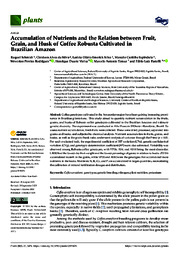Accumulation of nutrients and the relation between fruit, grain, and husk of coffee robusta cultivated in brazilian amazon.
Accumulation of nutrients and the relation between fruit, grain, and husk of coffee robusta cultivated in brazilian amazon.
Autoria: SCHMIDT, R.; SILVA, C. A. da; SILVA, L. O. E.; ESPINDULA, M. C.; RODRIGUES, W. P.; VIEIRA, H. D.; TOMAZ, M. A.; PARTELLI, F. L.
Resumo: Coffee genotypes cultivated in the Amazonian region have been gaining increasing prominence in Brazilian plantations. This study aimed to quantify nutrient accumulation in the fruits, grains, and husks of Robusta coffee genotypes cultivated in the Brazilian Amazon and estimate genetic diversity. The experiment was conducted in Alta Floresta D’Oeste—Rondônia, Brazil. To assess nutrient accumulation, fresh fruits were collected. These were dried, processed, separated into grains and husks, and subjected to chemical analysis. Nutrient accumulation in fruits, grains, and husks, as well as the grain/husk ratio, underwent analysis of variance through the F-test (p < 0.01. For each evaluated trait, the experimental coefficient of 337 variation (CVe), genetic coefficient of variation (CVg), and genotypic determination coefficient (H2) were also estimated. Variability was observed among Robusta coffee genotypes, with VP06, AS4, and AS10 being the most dissimilar. LB080 had the lowest dry fruit weight and the lowest percentage of grains in relation to husks. ZD156 accumulated more K in the grains, while VP06 and AS10 were the genotypes that accumulated more nutrients in the husks. Nutrients N, K, Ca, and P are accumulated in larger quantities, necessitating the calibration of mineral fertilization dosages and distribution.
Ano de publicação: 2023
Tipo de publicação: Artigo de periódico
Unidade: Embrapa Café
Palavras-chave: Café Robusta, Coffea Canephora, Genotype, Nitrogen, Plant breeding, Plant nutrition, Potassium
Observações
1 - Por padrão são exibidas publicações dos últimos 20 anos. Para encontrar publicações mais antigas, configure o filtro ano de publicação, colocando o ano a partir do qual você deseja encontrar publicações. O filtro está na coluna da esquerda na busca acima.
2 - Para ler algumas publicações da Embrapa (apenas as que estão em formato ePub), é necessário ter, no celular ou computador, um desses softwares gratuitos. Sistemas Android: Google Play Livros; IOS: iBooks; Windows e Linux: software Calibre.
Acesse outras publicações
Acesse a Base de Dados da Pesquisa Agropecuária (BDPA) para consultar o acervo completo das bibliotecas da Embrapa.

